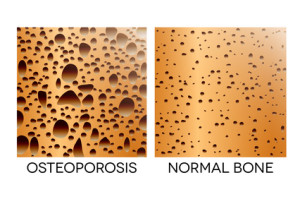According to the National Osteoporosis Foundation, 1 out of 2 women and 1 out of 4 men over 50 will have a wrist, hip, or spine fracture due to osteoporosis. If you have osteoporosis or osteopenia you should learn how to exercise properly and safely in order to decrease the risk the progression of this disease. Effective and safe exercise can improve your quality of life, overall health, and keep your osteoporosis under control.
Osteoporosis means porous bone and is a disease that weakens bones. It is a serious health issue placing 44 million people at risk for this debilitating disease. The disease can cause bones to fracture or break easily. The most common sites for breaks are the hips, spine and wrists, although a break can occur in any bone. A broken hip or spine usually requires a hospital stay or surgery so they are of particular concern. It can also lead to permanent pain, disability, or death.
Our bodies are always breaking down bone and replacing it with new bone. In the reabsorption stage, the old bone is broken down and in the formation stage, new bone is built. This process of renewal occurs throughout our lives. As we age, bone-forming cells slow down which causes bone to be lost at a faster pace then it is formed. Bone is a living issue, which contains small little spaces, which get larger as we lose bone density. To make matters worse, the outside of the bone thins as well.
Bone loss occurs in everyone, as we get older. Osteoporosis arising a result of an acceleration of this process is called primary osteoporosis. Many times osteoporosis begins in middle age as hormone levels change or at an older age associated with a vitamin D deficiency. Secondary osteoporosis is caused by some medications and disease processes. Half of women and men over age 70 may have this disease.
It is a silent disease because it progresses without symptoms. There are no symptoms in the very early stages. Most people do not know that they have it until a bone breaks. It can be from a fall or something as slight as a bear hug. A sneeze or sudden movement can be enough to break a bone in someone with severe osteoporosis. Later in the disease kyphosis or a stooped posture becomes noticeable. A dowager’s hump may also become apparent. There can be neck or back pain due to fractures or bone tenderness. Loss of height can occur – even up to 5 or 6 inches.

Reduced bone density can be seen on a DEXA scan. People over age 50 have this scan performed routinely to test bone mineral density. This number, called a T score that compares bone density to a 25 year old. A score of –1 to –2.5 indicates osteopenia, which suggests the beginning of osteoporosis while a T score greater than – 2.5 is considered osteoporosis.
Who is at risk?
There are risk factors-some are controllable and some are not.
Women are at higher risk than men. They have smaller bones and there may be issues, which increase risk such as: late menarche, amenorrhea, and hysterectomy at young age. Older people are at risk, as there bones get thinner. Osteoporosis seems to run in families and those that have had a fracture after 50 are considered to be at higher danger. Caucasians and Asians are at higher risk, as are smokers and alcohol use, being thin, doing little exercise, and a diet without sufficient vitamin D and calcium. Calcium and phosphate are essential for bone formation. If you do not get enough calcium or your body does not absorb enough calcium, it will hurt bone production. Other risk factors: rheumatoid arthritis, type 1 diabetes, anorexia, premature menopause, asthma, multiple sclerosis, lupus, some antacids, cancer treatments, and thyroid, gastrointestinal, blood and renal disorders.
Why is osteoporosis increasing?
Lack of physical activity and poor diet is increasing the prevalence of osteoporosis. Only a small percentage of us have jobs that involve physical activity and most of us have sedentary lifestyles. Osteoporosis is increasing for many of the same reasons the prevalence of obesity is increasing. Although some of increase can be attributed to an increase in testing at age 50, the more likely causes are reduced physical activity and poor diet
There are medications that help control this disease, but these may have side effects. Try to participate in weight bearing exercise and follow a bone healthy diet. Our goal is to keep the bones dense; strength training not only increases muscle mass it also can stimulate the bone. We want to increase the muscle mass so there is more of it pulling on the bone.

